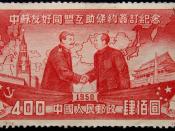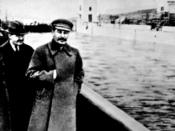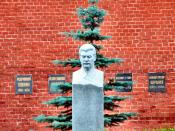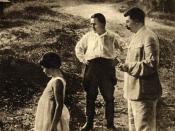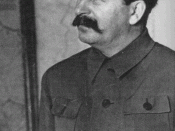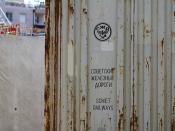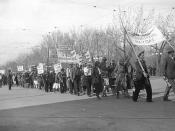Two totalitarian governments, the Communist Party under Stalin and the fictional Ingsoc under Big Brother, have conducted political purges. These purges were used to wipe out political opposition, to root out seeds of rebellion, and to "cleanse" society. Both of these totalitarian governments had their own methods, but their purpose was the same: to create dystopian societies riddled with oppression, devoid of freedom.
The political purge was primarily an effort by the center faction of the Party, led by Stalin, to eliminate opposition from the Party's left and right wings, led by and Nikolai Bukharin, respectively. Following the Civil War and reconstruction of the Soviet economy in the late 1920s, the "temporary" wartime dictatorship which had passed from Lenin to Stalin seemed no longer necessary to veteran Communists. Stalin's opponents on both sides of the political spectrum chided him as undemocratic and lax on bureaucratic corruption (Lang 1). These tendencies may have accumulated substantial support among the working class by attacking the privileges and luxuries the state offered to its high-paid elite.
The Ryutin Affair seemed to vindicate the fears of Stalin's clique. He therefore initiated a ban on party factions and banned those party members who had opposed him, effectively ending democratic centralism. In the new form of Party organization, the Politburo, and Stalin in particular, were the sole dispensers of communist ideology (Lang 1). This necessitated the elimination of all Marxists with different views, especially those among the prestigious "old guard" of revolutionaries. Communist heroes like Tukhachevsky and Bela Kun, as well as Lenin's entire politburo, were shot for minor disagreements in policy. The NKVD was equally merciless towards the supporters, friends, and family of these heretical Marxists, whether they lived in Russia or not. (Illic 1) The most infamous case is that of Leon Trotsky, whose family was almost annihilated, before he himself was killed in Mexico by NKVD agent Ramon Mercader, who was part of an assassination task force put together by Special Agent Pavel Sudoplatov, under the personal orders of Joseph Stalin. (Lang 1) The elimination of Stalin's political enemies could be compared the vaporization of Party members Syme and Parsons. Syme was simply vaporized because he liked his job too much, and Parsons was arrested for muttering "Death to Big Brother" in his sleep (Orwell). While Stalin's rivals actually posed as valid threats, Syme and Parsons were simply unfortunate victims betrayed by their own minds. These examples go on to show the paranoia that riddled both totalitarian parties, although Ingsoc was much more meticulous about their purges.
While purges can be conducted to eliminate rivals, they can also be conducted en masse. In 1929 through 1938, Stalin conducted the Great Purge. Mass repression was used against the kulaks during the collectivization drives of 1929 through 1931. (citation) The term kulak came to encompass not only the wealthy peasantry, but also all those who opposed collectivization. There was a significant increase in the numbers of individuals arrested and convicted in 1930 and 1931, with many thousands being sent to the forced labor camps or into exile. The numbers of executions also showed a significant increase in these years, now reaching into the tens of thousands. (Illic 1) The process of arrest and conviction was on-going in the first half of the 1930s, with the vast majority of those sentenced being sent to the gulag or into exile. The number of executions reached a peak in 1937 and diminished only slightly in 1938. Official documentation reveals that 681,692 people were shot in these years. (Illic 1) This is when the Purge became truly "Great". The Great Terror itself can be divided into two distinct phases: first, the purge of the nomenklatura and, second, the mass operations. The nomenklatura involved the high profile cases often reported in the Soviet press and by Soviet emigres. It focused partly on officials in the economic commissariats, and has been broadly attributed to a generational conflict in the Soviet political elite. It is only more recently that we have learned the details of the mass operations. The Great Terror continued into the early years of the Second World War and beyond, but much less research has been conducted into these events. The Mass Operations was where Stalin was famous for his midnight purges: he would round up hundreds of citizens at a time and murder them en masse in deserted areas, much as Oceania citizens are "vaporized." Stalin's victims were his imagined enemies, such as political dissidents or Jews, while Ingsoc's were thought criminals and Eurasian (or, near the end of the novel, East Asian) prisoners of war. Stalin also purged the Red Army. The crisis that engulfed the Red Army in the late 1920s and the subsequent purging of some of its members in the late 1930s stemmed from the dissatisfaction of the ordinary rank and file soldiers. Higher officials deemed it necessary that the oppositionists be eliminated since they were concerned that some senior military officers would eventually share the oppositionists' sentiments. The opposition group was against the unified command policy and demanded better social conditions, including better housing and higher salaries. These Mass operations were highly brutal and genocidal in comparison to the fictional society of 1984. In Oceania, the mass purges did not focus on mass murder as much as sending victims to labor camps, although these instances occurred in Stalinist Russia also.
Overall, the Party did not go as far as Stalin in terms of murder and forced labor, but it was much more meticulous at concealing vaporizations from the general public and each operation of the Party was much more insidious goal. As stated by O'Brien, Ingsoc's goal was not to create a "utopian society" by purging; it wanted to gain power through the means of creating a dystopian society devoid of freedom of thought. He said the main flaw with Stalinist Russia was that they used power as a mean, not an end; and that is why the Soviet Union fell. (Orwell 1) While the efficiency of each ruling totalitarian government was marginally different, both used purges to destroy threats to the party and its leader.
Works CitedIlic, Melanie. "The great terror reassessed: how can we seek to make sense of Stalin's reign of terror?." 20th Century History Review 1.3 (April 2006): 7(5). General OneFile. Gale. Robinson High School. 20 May 2008.
Lang, Sean. "Terror under Stalin. (Aiming high)." Modern History Review 14.3 (Feb 2003): 12(3). General OneFile. Gale. Robinson High School. 21 May 2008.
Krushchev, Nikita. Special Report to the 20th Congress of the Communist Party of the Soviet Union. February 25, 1956Orwell, George. 1984. GB, England: Penguin Books, 1949.
